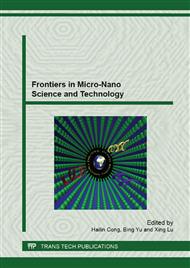[1]
O.P. Sharma. Antioxidant activity of curcumin and related compounds, Biochem Pharmacol. 25 (1976) 1811–1812.
Google Scholar
[2]
R.R. Satoskar, S.J. Shah S.G. Shenoy. Evaluation of anti-inflammatory property of curcumin (diferuloyl methane) in patients with postoperative inflammation, Int. J. Clin. Pharm. Ther. Toxi. 24 (1986) 651–654.
Google Scholar
[3]
R. Kuttan, P. Bhanumathy, K. Nirmala, M.C. George. Potential anticancer activity of turmeric (Curcuma longa), Cancer Lett. 129 (1985) 197–202.
DOI: 10.1016/0304-3835(85)90159-4
Google Scholar
[4]
H.H. Tonnesen, M. Masson, T. Loftsson, Studies of curcumin and curcuminoids. XXVII. Cyclodextrin complexation: solubility, chemical and photochemical stability, Int. J. Pharm. 244 (2002) 127–135.
DOI: 10.1016/s0378-5173(02)00323-x
Google Scholar
[5]
Y.J. Wang, M.H. Pan, A.L. Cheng, Stability of curcumin in buffer solutions and characterization of its degradation products, J. Pharm. Biomed. Anal. 15 (1997) 1867–1876.
Google Scholar
[6]
K.Y. Yang, L.C. Lin, T.Y. Tseng, S.C. Wang, T.H. Tsai, Oral bioavailability of curcumin in rat and the herbal analysis from Curcuma longa by LC–MS/MS, J. Chromatogr. B. 853 (2007) 183–189.
DOI: 10.1016/j.jchromb.2007.03.010
Google Scholar
[7]
A.A. Date, M.S. Nagarsenker, Parenteral microemulsions: An overview, Int. J. Pharm. 355(2008) 19–30.
Google Scholar
[8]
H.N. Bhargava, A. Narurkar, L.M. Lieb, Using microemulsions for drug delivery, Pharm. Techol. 11 (1987) 46-54.
Google Scholar
[9]
M.J. Lawrence, G.D. Rees, Microemulsion-based media as novel drug delivery systems, Adv. Drug Deliv. Rev. 45 (2000) 89–121.
DOI: 10.1016/s0169-409x(00)00103-4
Google Scholar
[10]
J. Cui, B. Yu, Y. Zhao,W. Zhu, H. Li, Hongxiang Lou and Guangxi Zhai, Enhancement of oral absorption of curcumin by self-microemulsifying drug delivery systems, Int. J. Pharm. 371 (2009) 148–155.
DOI: 10.1016/j.ijpharm.2008.12.009
Google Scholar
[11]
L. Hu, Y. Jia, F. Niu, Z. Jia, X. Yang and K. Jiao, Preparation and enhancement of oral bioavailability of curcumin using microemulsions vehicle, J. Agr. Food Chem. 60 (2012) 7137−7141.
DOI: 10.1021/jf204078t
Google Scholar
[12]
M.H. Lee, H.Y. Lin, H.C. Chen, J.L. Thomas, Ultrasound mediates the release of curcumin from microemulsions, Langmuir. 24 (2008) 1707-1713.
DOI: 10.1021/la7022874
Google Scholar
[13]
Z. Wang, W. Zhou. Lamellar Liquid Crystals of Brij 97 Aqueous solutions containing different additives. J. Solution Chem. 38 (2009).
DOI: 10.1007/s10953-009-9399-y
Google Scholar
[14]
Z. Wang, P. Cheng, Z. Li, J. Lu, Z. Diao, W. Zhou, Microstructure of microemulsion as curcumine carrier formed in Tween80/Isopropanol/Ethyl Butyrate/Normal Saline system, Food & Drug. 14 (2012).
Google Scholar
[15]
A. Friggeria, B.L. Feringa, J. van Esch, Entrapment and release of quinoline derivatives using a hydrogel of a low molecular weight gelator, J. Control. Release. 97 (2004) 241–248.
DOI: 10.1016/j.jconrel.2004.03.012
Google Scholar
[16]
M. Wang, F. Liu, C. Lin, Q. Zhang, Y. Zhang, J. Liu, X. Wang. Impacts of different drying methods on anti-oxidant activity and chemical ingredients of honeysuckle by chemiluminescence detection, Shandong Sci. 56 (2013) 56-60.
Google Scholar
[17]
M. Clausse, L. Nicolas Morgantini, A. Zradba. Water/sodium dodecylsulfate/l pentanol/N-dodecane microemulsions, Realms of existence and transport properties. In Rosano, H.L. and Clausse, M. (Eds. ), Microemulsion systems, Marcel Dekker Inc., New York, Basel, 1987b, pp.387-425.
DOI: 10.1007/bf01422860
Google Scholar
[18]
G. Feng, Y. Xiong, H. Wang, Y. Yang, Gelation of microemulsions and release behavior of sodium salicylate from gelled microemulsions, Eur. J. of Pharm. Biopharm. 71 (2009) 297-302.
DOI: 10.1016/j.ejpb.2008.08.014
Google Scholar


